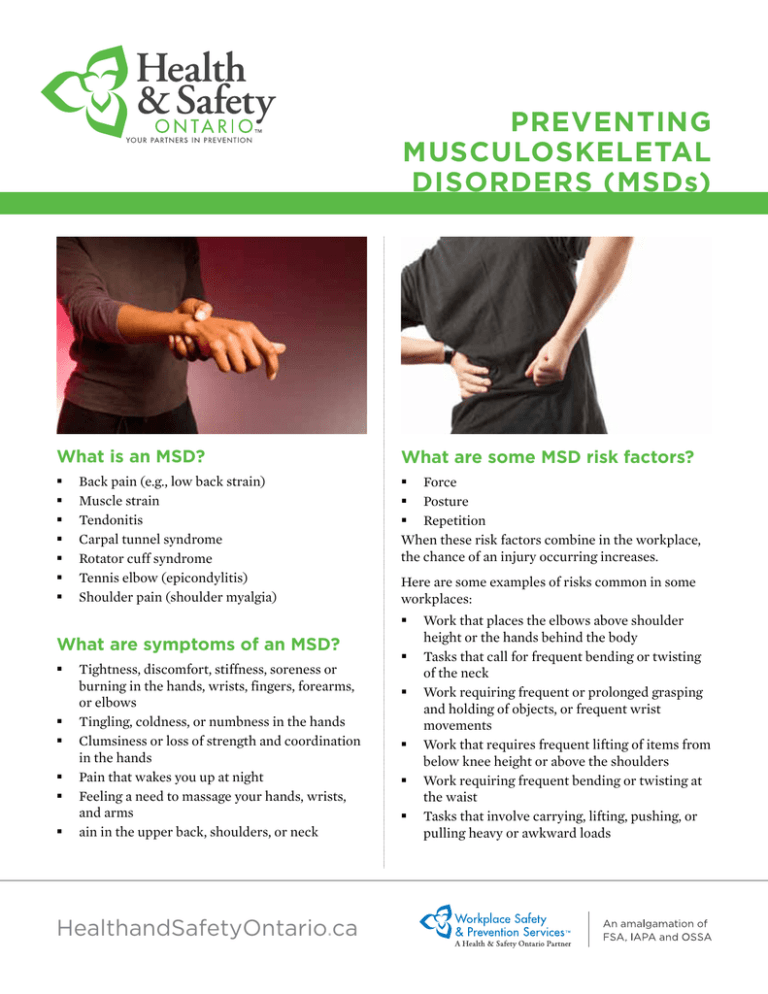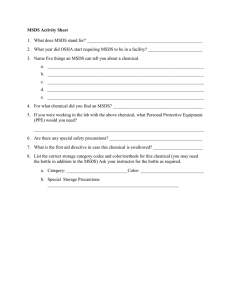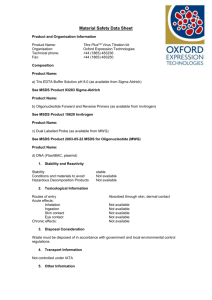Preventing MuSculoSkeletal DiSorDerS (MSDs)
advertisement

Preventing Musculoskeletal Disorders (MSDs) What is an MSD? What are some MSD risk factors? Force Posture Repetition When these risk factors combine in the workplace, the chance of an injury occurring increases. Back pain (e.g., low back strain) Muscle strain Tendonitis Carpal tunnel syndrome Rotator cuff syndrome Tennis elbow (epicondylitis) Shoulder pain (shoulder myalgia) What are symptoms of an MSD? Tightness, discomfort, stiffness, soreness or burning in the hands, wrists, fingers, forearms, or elbows Tingling, coldness, or numbness in the hands Clumsiness or loss of strength and coordination in the hands Pain that wakes you up at night Feeling a need to massage your hands, wrists, and arms ain in the upper back, shoulders, or neck HealthandSafetyOntario.ca Here are some examples of risks common in some workplaces: Work that places the elbows above shoulder height or the hands behind the body Tasks that call for frequent bending or twisting of the neck Work requiring frequent or prolonged grasping and holding of objects, or frequent wrist movements Work that requires frequent lifting of items from below knee height or above the shoulders Work requiring frequent bending or twisting at the waist Tasks that involve carrying, lifting, pushing, or pulling heavy or awkward loads Preventing Musculoskeletal Disorders (MSDs) Spending long periods with a body part held in any one position without movement Psychosocial factors relating to work demands, such as control over work and effort-reward imbalance in the job Other risks include using vibrating tools, working in cold environments, high contact stress or sharp edges What are common MYTHS about pains and strains in the workplace? MSDs only develop in workers involved in manual labour - It can’t happen to me! –– Some studies suggest that 80% of people will develop back pain at some point in their lives –– People in light office jobs are as likely to experience back pain as labourers if they have to sit in an awkward position for long periods of time MSDs occur most frequently in the arms and hands, such as carpal tunnel syndrome, rotator cuff syndrome, tennis elbow, and shoulder pain –– An MSD can occur in almost any part of the body –– In fact, the body part most often affected by an MSD is the back –– The latest research suggests that most spinal discs are injured by cumulative weight being applied – essentially, it’s like ‘the straw that broke the camel’s back’ People need to be reminded to bend their knees when they lift in order to prevent an MSD –– Yes, it’s true that we have greater strength and mechanical advantage by bending the knees 2 © 2011, Safe Workplace Promotion Services Ontario, publicly known as Workplace Safety & Prevention Services. 1 877 494 WSPS (9777) | 905 614 1400 | www.wsps.ca –– However, it’s just as important to maintain your back’s natural curves, especially the arch in your lower back, when lifting an item –– Also, take a close look at the job you’re doing and see if you can reduce the amount of lifting, carrying, and climbing MSDs are just a natural part of getting old –– A surprising number of young people are reporting MSDs at work and at home –– ‘Blackberry thumb’ is the newest MSD of the computer age –– While it’s true that certain disorders, such as degenerative disc disease, are part of the aging process, it’s possible to still have a healthy body as you get older –– It’s not age that dictates the onset of an MSD, it’s the risk factors that you’re exposed to and your work practices Ergonomics is just the latest buzzword in how to prevent MSDs – prevention is really just basic common sense –– MSDs were first documented by Bernardino Ramazzini, the father of occupational medicine, in 1713 –– The term ‘ergonomics’ was first used by a Polish educator and scientists, Wojciech Jastrzebowski (1799-1882) –– For centuries, people have been trying to ‘work smarter, not harder’ –– Those who have been successful have realized that it is more than just common sense and it often is not common practice –– The main goal of ergonomics is to reduce the risk of MSDs by matching the demands of the job to the abilities of the worker through proper design of workstations, tools, environment, work schedules, policies, and procedures Preventing Musculoskeletal Disorders (MSDs) How can I prevent MSDs? Job Tasks Vary your activities to change your posture and the muscles you are using Perform simple stretching exercises to reduce muscular discomfort Get out and go for a walk for some fresh air When you have to put your load on a flat surface, make sure that there are blocks or shims so that your fingers will not be pinched For more information, advice, a detailed assessment, or ergonomics training, contact an ergonomics specialist at WSPS or visit the HSO website at www.healthandsafetyontario.ca Workstation and Tools Adjust your workstation and to meet your (e.g., adjust the working height so the elbows are bent approximately 90° by using adjustable seating, using sturdy, stable step-stools to raise shorter workers, and using adjustable work benches to improve neck and back posture Maintain a neutral, relaxed posture, and work in a comfortable position, for example by selecting a tool with the proper angle or grip Keep tools and equipment well maintained to reduce effort – for example, sharp knives require less force; well-maintained lift trucks transmit less vibration to the driver Keep frequently used tools, supplies, and equipment within your arm’s natural reach Safe Lifting Take a balanced stance – put your feet shoulderwidth apart Get close to the object and squat down to pick up the load Test the weight of the load before trying to lift it Get a firm grip on the load and keep it close to your body Face the direction you will be moving in so that you do not have to turn during your lift Do not twist your body while you are lifting Lift the load gradually and smoothly, keeping your back and neck straight © Workplace Safety & Prevention Services 2011. Workplace Safety & Prevention Services (WSPS) grants permission to approved end users to reproduce this document in whole or in part, provided its intended use is for non-commercial, educational purposes and that full acknowledgement is given to the WSPS. Approved end users are firms registered with the Workplace Safety and Insurance Board. WSPS reserves the right to extend this permission to other stakeholders and interested parties by express written permission upon application. WSPS extends no warranty to materials amended or altered by the end user. Under no circumstances is this document, or any portion thereof, to be duplicated for purposes of sale or for external reproduction or distribution. Revised: November 2011 3 © 2011, Safe Workplace Promotion Services Ontario, publicly known as Workplace Safety & Prevention Services. 1 877 494 WSPS (9777) | 905 614 1400 | www.wsps.ca


